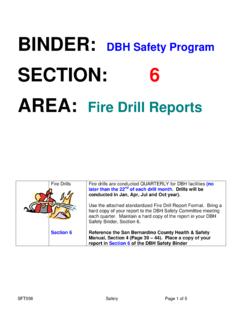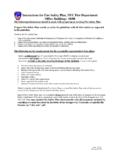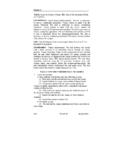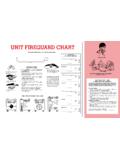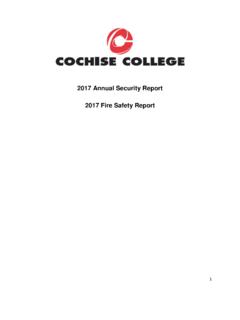Transcription of Important Ontario Fire Code Information for Building ...
1 Important Ontario fire code Information for Building Owners in the City of Windsor This Information is intended to be used a reference only. For a complete listing consult the Ontario fire code or contact the Windsor fire & Rescue Services fire Prevention at 519-253-6573, or, email Remember, it is the Building Owner, unless otherwise specified, who is responsible for carrying out the provisions of the Ontario fire code (Div A, ) EXCERPTS FROM THE Ontario fire code ( Ontario reg. 213/07) Div.
2 B Article Where tests, repairs or alterations are made to fire protection installations, including sprinkler and standpipe systems, a procedure of notification shall be established and the procedure shall include notifying the fire department and the Building occupants where necessary for safety in the event of a fire emergency. Div B Article (1) If this code requires tests and corrective measures or operational procedures to be carried out, records shall be made and the original or a copy shall be retained at the Building premises for examination by the Chief fire Official.
3 (2) Records of tests and corrective measures or operational procedures shall be retained so that at least the current and the immediately preceding reports are available. (3) Despite Sentence (2), records shall be retained for a period of at least two years after being prepared. (4) In addition to the requirements of Sentences (1), (2) and (3), in facilities regulated by or under the Developmental Services Act, written records shall be kept of inspections for two years after they are made, and the records shall be available upon request to the Chief fire Official.
4 Div B Article (1) The initial verification or test reports for fire protection systems installed after November 21, 2007 shall be retained throughout the life of the systems. DEFINITIONS CHECK means a visual observation to ensure the device or system is in place and is not obviously damaged or obstructed. INSPECT means physical examination to determine that the device or system will apparently perform in accordance with it's intended function TEST means operation of device or system to ensure that it will perform in accordance with its intended operation or function.
5 APPROVED means approved by the Chief fire Official Building means any structure used or intended for supporting any use or occupancy CHIEF fire OFFICIAL means the Municipal fire Chief or a member or members of the fire department designated by the Municipal fire Chief or a person appointed by the fire Marshal under Sub-section OWNER means any person, firm or corporation having control over any portion of the Building or property under consideration and includes the persons in the Building or property.
6 RETROFIT means the minimum performance requirements for life safety for existing buildings. SUPERVISORY STAFF means those occupants of a Building who have some delegated responsibility for the fire safety of other occupants under the fire safety plan. MANDATORY fire SAFETY MAINTENANCE SCHEDULE DAILY fire code Div B Reference # (1) CHECK exit signs to ensure they are in clean and legible condition. (2) CHECK exit lights to ensure they are illuminated and in good repair. (3) CHECK torches, regulators and welding equipment for defects.
7 (4) CHECK fire alarm system AC power lamp. (5) CHECK central alarm and control facility to ensure that no trouble is indicated. (6) CHECK tank heating equipment and accessories to ensure they are in operating condition and heater valves are open (7) CHECK temperature of water contained in tanks to ensure it does not fall below the freezing temperature (8) CHECK temperature of tank enclosure for tanks in buildings to ensure temperature of tank does not fall below the freezing temperature (9) CHECK temperature of fire pump rooms during freezing weather.
8 WEEKLY (1) CHECK hoods, filters and ducts in ventilation systems subject to accumulation of combustible deposits. (2) CHECK that sprinkler system control valves are open. (3) CHECK that dry pipe sprinkler system air pressure is being maintained. (4) INSPECT valves controlling fire protection water supplies. (5) CHECK the water level and air pressure for fire protection system water tanks. (6) INSPECT relief valves on air and water supply lines of fire protection system pressure tanks. (7) CHECK water level in fire pump reservoirs.
9 (8) INSPECT and operate all fire pumps (9) CHECK all components of emergency generator system set under at least 50% of the rated load for 30 minutes. MONTHLY (1) INSPECT all doors in fire separations. (2) INSPECT and TEST emergency lighting systems, batteries, units and lamps. (3) CONDUCT fire drills for Supervisory staff in day care and health care facilities. (4) TEST all welding equipment. (5) INSPECT all portable fire extinguishers. (6) TEST fire alarm system and check all components including standby power batteries.
10 (7) TEST the voice communication system. (8) INSPECT all fire hose cabinets. (9) TEST the sprinkler system alarm. (10) INSPECT the water level in gravity fire protection water tanks. EVERY TWO MONTHS (1) TEST sprinkler system central station connections. EVERY THREE MONTHS (1) CONDUCT a fire alarm drill for supervisory staff in all high-rise buildings. (2) TEST all fire safety devices in high buildings as defined by sub-section of the Building code . (3) TEST firefighters elevator for proper operation.
